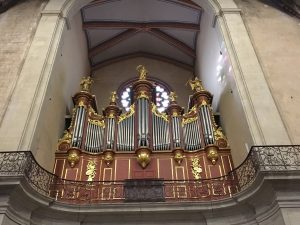It was only 150 miles from Nimes to Carcassone, but I was drawn to a little museum 18 miles in the other direction — Le Musee du BonBon — the Haribo Museum near Uzes. For those of you who really know me, you’ll understand completely my urge to visit a palace to those nothing-but-sugar gold bears. Since Kimberly had headed out on an early train to get to Paris in time for her flight, I took a leisurely morning, and pointed the car north. Uzes is a medieval hilltop village, and the road there was curving and narrow, and at one point I drove over a Roman Bridge over the Gardon River, the same river as the Pont du Gard — I was heading in that direction, but along a different route.
The museum is a paean to sugar, with the history, sourcing, processing and displays all about it. And it’s clear that Mr. Riegel, who founded Haribo (Ha for Hans, Ri for Riegel and Bo for Bonn) was a dedicated and savvy businessman, merging and buying up other confectionary companies along the way. The museum was colorful and interactive, and ended in a gift shop (surprise!), so it was everything I had hoped. A break from castles and abbayes and cathedrals and a tribute to the Candy Man.
The drive to Carcassone was all along an autoroute (the French version of a toll road interstate, privately run). My 150 miles cost about $22, so clearly you are paying for the speed — 78 MPH gets you places fast. I stopped along the way for a picnic lunch, having bought a baguette sandwich at a lovely and very busy bakery just outside Uzes. I arrived at my hotel, which sits along the Audie River, just after 3PM, and had time to get oriented, find the tourist office and have a stroll around town.
Carcassone is really two towns: the upper, original, medieval city, and the lower town, also called the Bastide Saint Louis which was built in the 13th Century across the river from the older section. Today I walked through the latter — saving hilltop village for tomorrow — which still had several noteworthy sights. In the Gambetta Square I was taken with a statue to the French Resistance during WWII — elegant and appropriately next to the French flag. In Place Carnot is the Fountain of Neptune, sculpted by father and son Barata in 1771. At the end of the shopping street is the Canal du Midi, which was constructed during the 17thC to link the Atlantic with the Mediterranean, to transport goods and passengers. It is listed as a UNESCO site. The Church of Saint Vincent had begun being build in the 14thC in the gothic style of the Languedoc region. The nave is the largest in Southern France. It’s possible to climb the 232 steps to the top of the bell tower, so I did. There were wonderful views of the entire region and the ancient city in the distance. The other church of the town is now a cathedral — Saint Michel — was also built in the same style, in the 16thC, when the town outgrew Saint Vincent’s. The portal of the Jacobins from 1778 provides an entry gate to the town.
Then it was back to my hotel and dinner at the restaurant here, which provided a wonderful view of the medieval city as the light faded. I’m looking forward to exploring that tomorrow. And not driving at all.














